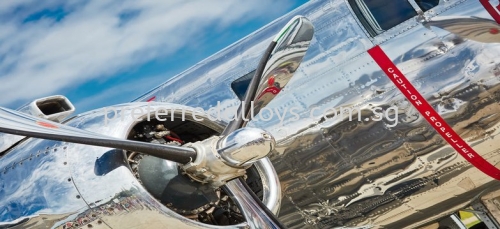Aluminum is an amazing metal that has transformed many different industries over the past one hundred years. Nowhere is this probably more true than the aircraft industry. Due to aluminum’s advantages over other metals, including its light weight and incredible strength, airplanes rely on this material in order to be a safe, affordable, feasible form of transportation.
Although the history of airplanes dates to 1903 with the first flight of the Wright Brothers, the dream of aviation goes back much further. Leonardo da Vinci made fanciful designs of flying machines as far back as the 15th century. It wasn’t until the 20th century, with its combination of engineering and technology advances, that this dream was fully realized.
Once the mechanics of flight became possible, it was necessary to create machines that were both safe and reliable. In order to do so, the most important consideration was having materials strong enough to be safe while remaining light enough to reduce the amount of power required to become airborne. That’s why aluminum became a necessity; it was even used in the Wright Brothers earliest planes. Although their biplane was primarily constructed from wood and cloth, the crankcase for the engine was made of aluminum.
Why aluminum is used in the aircraft industry?
The two most prominent reasons aluminum is so indispensible to the aerospace industry have already been mentioned. As one of the metals with the highest strength to weight ratio, it’s value to the aerospace industry is obvious. Airframes must be strong and durable enough to withstand the stresses of takeoffs and landings over time. At the same time, if the metal is too heavy, this will require more fuel to be consumed during flights. This means that aluminum is often the most cost-effective choice for aircraft.
Strength and weight are not the only advantages of aluminum; another major benefit of aluminum alloys is their corrosion resistance. This is a major factor in the durability of an aircraft. Airplanes are constantly subject to the elements and regularly experience climactic extremes; freezing temperatures found at high altitudes and exposure to all sorts of precipitation, including snow and rainstorms. Aluminum is famous for its ability to withstand environmental corrosion.
Furthermore, aluminum also happens to be extremely formable. This is a blessing for the aircraft industry, which requires a high degree of precision to ensure maximum aerodynamics, not to mention all of the small parts that can be found on aircraft. Aluminum’s ease in fabrication and machining makes it another area in which it offers cost savings over alternative materials.
Aluminum is also aesthetically pleasing; while this is not the most important consideration, it doesn’t hurt since no one wants to fly in a vehicle that isn’t visually attractive (with perhaps the Millennium Falcon as the only exception).
It’s been estimated that 80% of all metal content in aircraft today is aluminum; it’s easy to see why.
What are the different ways aluminum is used?
First and most obvious, the skin of the airplane is typically made of aluminum. This is easy to see by anyone looking at an airplane if you know what to look for. But most other metal parts on the aircraft are also made of aluminum.
For instance, the engines of piston driven aircraft are built with aluminum. When the Wright Brothers were building their first plane, they originally used steel in the engine, but it proved too heavy and they chose aluminum. Today, many of the fasteners holding the airplane together are made from aluminum.
Most of the metal fixtures inside the plane, like seats, doors, cabinetry, etc., are made with aluminum. High performance plastics are now used for many of the overhead bins, but it’s still unusual to see other metals inside the plane. In fact, typically the only parts of an airframe made from a metal other than aluminum are those parts where the highest level of strength is critical, such as the landing gear. In these cases, highly alloyed specialty metals are used.
Which alloys are most commonly found in aircraft?
Since the aircraft (and aerospace) industry is so specialized, it’s no surprise that airplanes rely on specific, high-performing alloys. The alloy most closely related to aircraft applications is 7075. This association dates to its creation in 1930’s Japan, where it became the standard for airframe construction by the Japanese navy. It was introduced in the United States by Alcoa in 1943 and standardized for production in aircraft by 1945.
7075 is known for its excellent mechanical properties as well as its ductility, high strength, toughness and resistance to fatigue. 7075 is so strong as to be comparable to lower alloyed stainless steel grades and its reliability has made it a favorite of the aircraft industry since WWII.
Recently, newer, higher performing alloys have been developed and overtaken 7075 as the most popular choice in some aerospace applications. One example is 2024, whose chemistry makes it ideal for instances where high cyclical fatigue resistance is a concern.
Other popular alloys for the aircraft industry include 6061, 6063, 2014, 5052, 7050, 7085 and 7068.
Your technical services provider
When it comes to picking the correct material for an important job, your best bet is to consult the experts. At Preferred Alloys, our team of seasoned professionals understands the importance of getting it right the first time, and we’ll work with you through every step of the procurement process. As the Midwest’s leading aluminum supplier, our top priority is the success of our clients. Contact us today to speak to one of our friendly and knowledgeable sales representatives.
Published : 28-Dec-2022


